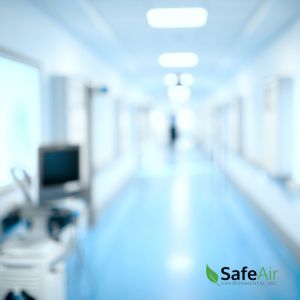The Benefits of Regular Air Quality Testing in Healthcare Facilities
Posted in Air Quality, on August 12, 2024
There’s a moment in the children’s film The Secret Garden where Mary throws open the shuttered windows of her cousin’s sick chamber. It’s after this scene that the cousin begins to get well and ceases being bedridden — the film makes a clear link between the dark, close, shut-in atmosphere of his bedroom and his malingering. This shows the SafeAir team just how important fresh, healthy air is when you’re recuperating and that healthy indoor air quality is a critical component of that process! Whether it’s radon testing, mold testing, or a generalized environmental assessment, creating a safe and healthy air environment in a healthcare or rehabilitation setting is critical to positive patient outcomes and the safe delivery of services.
Why Test?
 Air quality pollution affects more than just the nose. It affects:
Air quality pollution affects more than just the nose. It affects:
- The entire respiratory system, from the nose, mouth, throat, airways, and lungs
- The skin, our body’s largest organ, is especially vulnerable to airborne pollution
- The eyes, which have a delicate mucous membrane
- Hair
- Brain health and functioning
We’re not doctors, but we’re sure they would agree: good air is a foundation of good health, which is why testing for pollutants that are invisible, scentless, and leave no trace is essential.
What Are the Priorities of Air Quality Testing?
When it comes to testing indoor air quality, the SafeAir team has several priorities:
- We want to take an initial baseline reading to assess where your facility is at, which gives us an understanding of where you are and what you might need to improve on. It also provides a comparison for future tests and can help measure improvements.
- We want to identify pollutants that affect patients, visitors, and staff in the short term. Issues like mold growth, viruses, bacteria, and particulates may increase recovery times, for example.
- We want to identify pollutants that affect patients, visitors, and staff in the long term. Serious health problems caused by long-term exposure to radon and asbestos, for example, can increase an organization’s liability and affect people long after they stay or work at your facility.
- We want to offer actionable suggestions for improvements to airflow and air quality that will have positive mood, efficiency, and environmental effects on patients, visitors, and staff.
What Types of Air Quality Issues Do Healthcare Facilities Commonly Have?
A quick survey of news articles will show you that healthcare facilities in Ontario in recent years have had issues with airborne problems like Listeria bacteria, viruses like COVID-19, and other environmental and situational problems. Like any building, hospitals, nursing homes, rehab facilities, and other healthcare centers can develop acute or long-term air quality issues. Some of the common ones we see at SafeAir include:
- Reduced or obstructed airflow
- Inadequate filtration
- HVAC problems
- Outdoor pollution sources near air intake
- Environmental contaminants
- Radon gas
- Asbestos
- Construction debris
- Mold
- Carbon monoxide
Solutions for Healthcare Facilities
Whether we’re working with a massive organization like a general hospital or a small family practice, there is always a range of solutions that we can help you implement for improved air quality. Many of our most commonly suggested changes can be implemented quickly and with minimal cost or disruption to shifts, routines, or workflow. Some of the easiest ones we suggest include:
- Replacing or cleaning air filters on a faster schedule
- Increasing ventilation
- Using scent-free cleaning and maintenance products and implementing a scent-free environment
- Reduce indoor humidity levels to 40-50%
- Remove or monitor products containing asbestos
The Benefits of Better Air Quality
There are so many benefits to air quality improvement for patients, visitors, and staff beyond better general health and recovery. Some of the things SafeAir clients note include:
- Better sleep and rest
- Greater concentration
- Fewer sick days and less absenteeism
- Improved recovery from common cold and flu viruses
- Greater indoor comfort
- Improved skin and hair health
- Better mood
- Reduced asthma attacks and flare-ups from chronic conditions
Better Air Quality Starts with SafeAir
We’ve worked with hundreds of Ontarians to improve the air quality of their facility, workplaces, offices, or homes. We offer standardized air quality testing that looks at the entirety of your environment and the factors that affect it, or specialized services like radon testing to identify specific contaminants. To learn more about indoor air quality and health and book a test with our team, use our contact page to learn more.

